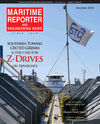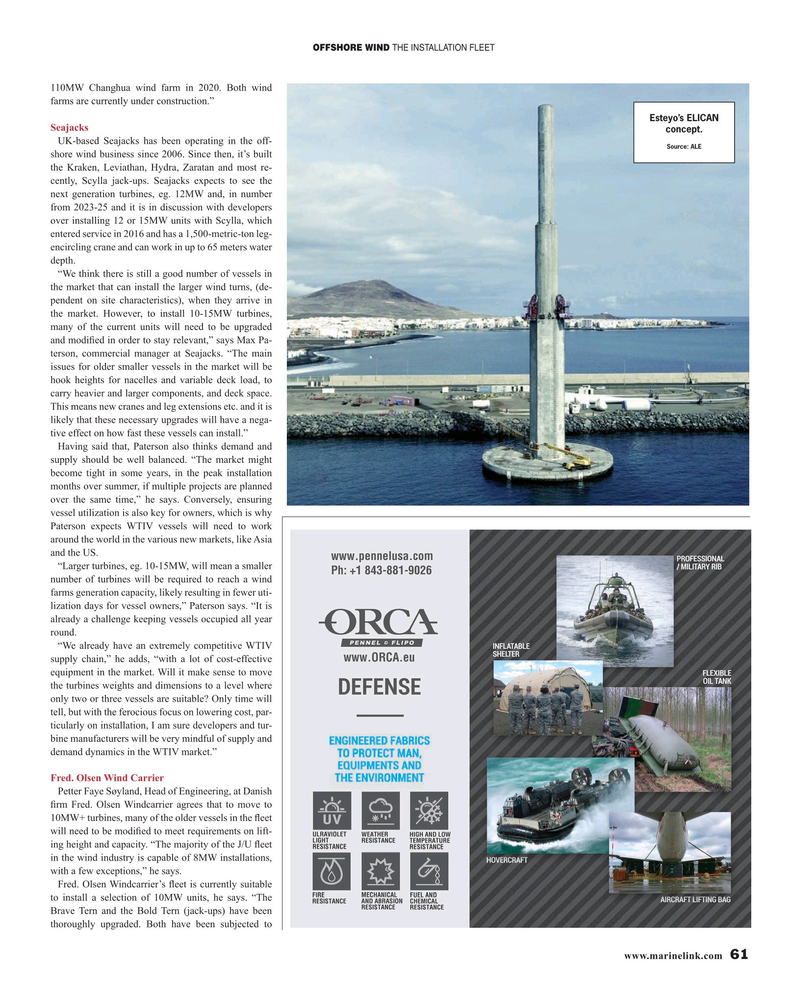
Page 61: of Maritime Reporter Magazine (November 2019)
Workboat Edition
Read this page in Pdf, Flash or Html5 edition of November 2019 Maritime Reporter Magazine
OFFSHORE WIND THE INSTALLATION FLEET 110MW Changhua wind farm in 2020. Both wind farms are currently under construction.”
Esteyo’s ELICAN
Seajacks concept.
UK-based Seajacks has been operating in the off-
Source: ALE shore wind business since 2006. Since then, it’s built the Kraken, Leviathan, Hydra, Zaratan and most re- cently, Scylla jack-ups. Seajacks expects to see the next generation turbines, eg. 12MW and, in number from 2023-25 and it is in discussion with developers over installing 12 or 15MW units with Scylla, which entered service in 2016 and has a 1,500-metric-ton leg- encircling crane and can work in up to 65 meters water depth. “We think there is still a good number of vessels in the market that can install the larger wind turns, (de- pendent on site characteristics), when they arrive in the market. However, to install 10-15MW turbines, many of the current units will need to be upgraded and modi? ed in order to stay relevant,” says Max Pa- terson, commercial manager at Seajacks. “The main issues for older smaller vessels in the market will be hook heights for nacelles and variable deck load, to carry heavier and larger components, and deck space.
This means new cranes and leg extensions etc. and it is likely that these necessary upgrades will have a nega- tive effect on how fast these vessels can install.”
Having said that, Paterson also thinks demand and supply should be well balanced. “The market might become tight in some years, in the peak installation months over summer, if multiple projects are planned over the same time,” he says. Conversely, ensuring vessel utilization is also key for owners, which is why
Paterson expects WTIV vessels will need to work around the world in the various new markets, like Asia and the US. “Larger turbines, eg. 10-15MW, will mean a smaller number of turbines will be required to reach a wind farms generation capacity, likely resulting in fewer uti- lization days for vessel owners,” Paterson says. “It is already a challenge keeping vessels occupied all year round. “We already have an extremely competitive WTIV supply chain,” he adds, “with a lot of cost-effective equipment in the market. Will it make sense to move the turbines weights and dimensions to a level where only two or three vessels are suitable? Only time will tell, but with the ferocious focus on lowering cost, par- ticularly on installation, I am sure developers and tur- bine manufacturers will be very mindful of supply and demand dynamics in the WTIV market.”
Fred. Olsen Wind Carrier
Petter Faye Søyland, Head of Engineering, at Danish ? rm Fred. Olsen Windcarrier agrees that to move to 10MW+ turbines, many of the older vessels in the ? eet will need to be modi? ed to meet requirements on lift- ing height and capacity. “The majority of the J/U ? eet in the wind industry is capable of 8MW installations, with a few exceptions,” he says.
Fred. Olsen Windcarrier’s ? eet is currently suitable to install a selection of 10MW units, he says. “The
Brave Tern and the Bold Tern (jack-ups) have been thoroughly upgraded. Both have been subjected to www.marinelink.com 61
MR #11 (59-65).indd 61 10/30/2019 11:06:03 AM

 60
60

 62
62
